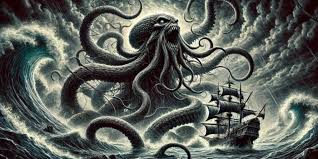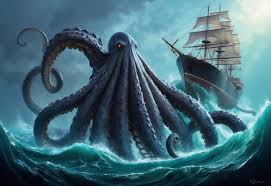The Kraken is a legendary sea monster that has haunted the imaginations of sailors and storytellers for centuries. Described as a colossal, tentacled creature capable of dragging entire ships into the depths, the Kracken embodies the fear and mystery of the unknown seas. Its origins in Scandinavian folklore and its enduring presence in modern culture make it one of the most iconic mythical creatures associated with maritime terror.
Origins of the Kraken Myth
Contents
- 1 Origins of the Kraken Myth
- 1.1 Physical Description and Characteristics
- 1.2 Symbolism and Cultural Significance
- 1.3 Stories and Legends of the Kraken
- 1.4 Scientific Inspirations and Connections
- 1.5 Influence on Modern Media
- 1.6 Psychological and Philosophical Perspectives
- 1.7 Modern Scientific Exploration and the Unknown
- 1.8 Enduring Legacy of the Kraken
- 2 Author

The Kraken’s legend originated in the seafaring communities of Scandinavia, particularly in the Icelandic sagas and Norwegian folklore. The first known written reference to the Kraken appears in the works of the 13th-century Icelandic historian Snorri Sturluson, who described a creature so vast that it could be mistaken for an island. Later, in the 18th century, Swedish naturalist Carl Linnaeus included the Kraken in his scientific classification system, listing it as a cephalopod under the name Microcosmus marinus. Although he later removed it from his works, this inclusion highlighted the semi-scientific intrigue surrounding the creature.
In Scandinavian lore, the Kraken was feared as an almost godlike entity that ruled the seas. It was believed to inhabit the waters off the coasts of Norway and Greenland, lying in wait for unsuspecting sailors. The Kracken’s immense size and destructive capabilities symbolized the dangers of the ocean and humanity’s vulnerability against the forces of nature.
Physical Description and Characteristics
The Kraken is most commonly depicted as a massive sea monster resembling a giant squid or octopus, though descriptions have varied over time. Its defining features include:
- Tentacles: The Kraken’s tentacles are said to be so large and powerful that they can wrap around ships, crushing them or dragging them underwater. Each tentacle is often described as lined with suction cups or barbs, adding to its terrifying appearance.
- Size: Early accounts describe the Kracken as being as large as an island. Some stories claim that sailors would mistake it for solid land, only to realize their mistake too late as the creature submerged.
- Behavior: The Kraken is known for its aggression, attacking ships without warning and creating whirlpools as it moves. Its presence is often marked by bubbling water and a sudden rise in sea levels, adding to its mystique.
- Intelligence: Despite its monstrous appearance, the Kracken is sometimes portrayed as an intelligent being, capable of strategic attacks and evading capture.
Symbolism and Cultural Significance

The Kraken is more than just a mythical creature; it is a powerful symbol of the ocean’s dangers and the mysteries that lie beneath the surface. For centuries, the sea represented an unknown and hostile world, and the Kracken embodied the fears of sailors who ventured into uncharted waters. Its monstrous form symbolizes the chaos and unpredictability of the natural world, serving as a reminder of humanity’s fragility.
In a broader sense, the Kraken also represents the unknown and the unseen. Its lurking presence beneath the waves echoes the human fear of what cannot be understood or controlled. This symbolism has made the Kracken a timeless figure in art, literature, and popular culture.
Stories and Legends of the Kraken
Numerous stories and accounts of the Kraken have been passed down through generations. One common tale describes the creature as lying dormant on the ocean floor, waiting for prey. When a ship sailed too close, the Kracken would rise from the depths, using its tentacles to drag the vessel and its crew underwater.
In some versions of the myth, the Kraken creates deadly whirlpools to pull ships into the depths. This ability to manipulate the sea itself adds to the creature’s legendary status, making it a force of nature rather than a mere animal.
Another recurring theme in Kraken legends is its association with treasure. Some sailors believed that the Kracken guarded sunken riches, tempting treasure hunters to risk their lives in search of fortune. This aspect of the myth ties the Kracken to greed and the perils of human ambition.
Scientific Inspirations and Connections
While the Kraken is a creature of myth, its legend is rooted in real-life encounters with giant sea creatures. The giant squid (Architeuthis dux) and colossal squid (Mesonychoteuthis hamiltoni) are two real-life species that share similarities with the Kraken. These massive cephalopods, which can grow up to 40 feet or more in length, have been known to inhabit the deep ocean and occasionally surface, leading to sightings that may have inspired Kracken tales.
The mysterious nature of these creatures, combined with their elusive behavior and formidable appearance, fueled speculation and fear among sailors. The discovery of massive squid carcasses and their distinctive tentacle scars on sperm whales further cemented the connection between the Kracken and real-life marine animals.
Influence on Modern Media

The Kraken has transcended folklore to become a staple of modern media and storytelling. Its fearsome image has appeared in numerous books, films, and video games, often serving as a formidable adversary or a symbol of the untamed sea.
In literature, the Kraken was immortalized in Alfred Lord Tennyson’s poem “The Kraken,” which describes the creature as a mysterious, otherworldly being dwelling in the ocean’s depths. In more lunatogel recent times, the Kracken has played prominent roles in fantasy and adventure narratives, such as Jules Verne’s 20,000 Leagues Under the Sea and Herman Melville’s Moby-Dick.
In cinema, the Kraken has been a memorable antagonist in films like Clash of the Titans, where its destructive power is unleashed upon coastal cities. Video games and tabletop role-playing games have also embraced the Kraken, with titles like Sea of Thieves and Dungeons & Dragons featuring the creature as a challenging foe.
Psychological and Philosophical Perspectives
The Kraken’s enduring appeal can be partly attributed to its psychological impact. As a representation of the unknown, the Kraken taps into primal fears of the dark, the deep, and the uncontrollable. It serves as a metaphor for humanity’s struggle against overwhelming odds and the inevitability of encountering forces beyond our comprehension.
Philosophically, the Kraken challenges us to confront our relationship with nature. It embodies the duality of the ocean as both a source of life and a place of danger. The Kraken’s immense power and mystery remind us of the limits of human understanding and the need for humility in the face of nature’s vastness.
Modern Scientific Exploration and the Unknown
The deep ocean remains one of the least explored regions of our planet, with much of it still shrouded in mystery. This uncharted territory fuels speculation about what creatures might still be undiscovered. While the Kraken itself may not exist, the possibility of finding similarly awe-inspiring animals keeps the legend alive.
Advancements in deep-sea exploration, such as remotely operated vehicles and submersibles, have brought us closer to understanding the mysteries of the ocean. Discoveries of previously unknown species, such as bioluminescent jellyfish and bizarre deep-sea fish, demonstrate that the ocean’s depths are home to creatures as strange and wondrous as the Kraken.
Enduring Legacy of the Kraken
The Kraken remains one of the most iconic symbols of maritime mythology. Its legend has evolved over time, adapting to cultural and technological shifts while retaining its core essence as a terrifying and mysterious force. From ancient folklore to modern entertainment, the Kraken continues to captivate and inspire, reminding us of the ocean’s beauty, danger, and endless potential for discovery.
As long as humanity is drawn to the sea and its mysteries, the Kracken will endure as a symbol of the unknown, a reminder of the power and majesty of nature, and an emblem of the unyielding human desire to explore and understand the world around us.





